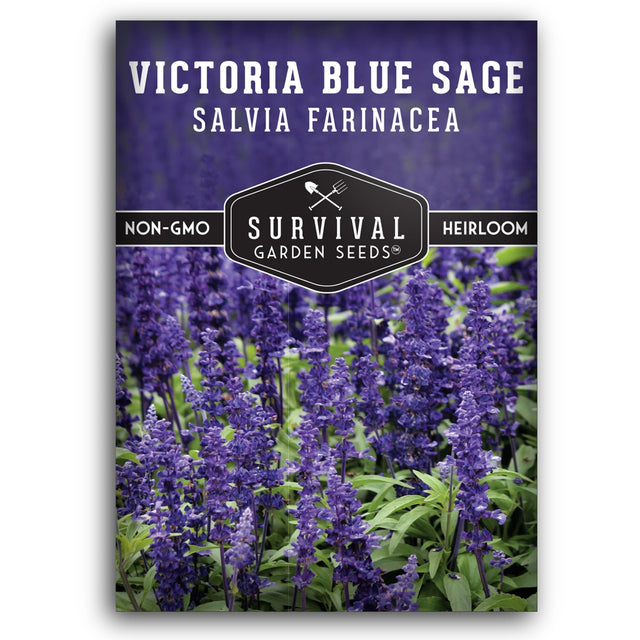Victoria Blue Sage Seeds – Native Drought-Tolerant Wildflower for Pollinator & Cut-Flower Gardens
Heirloom - Non-GMO - Reliable Germination
Victoria Blue Sage Seeds – Native Drought-Tolerant Wildflower for Pollinator & Cut-Flower Gardens is backordered and will ship as soon as it is back in stock.
Couldn't load pickup availability
Grow vibrant Victoria Blue Sage with Survival Garden Seeds. Also known as mealycup sage, this striking native wildflower is recognized by its deep blue-purple blooms and the distinctive powdery texture that coats its cup-shaped flowers. A reliable perennial in warm climates and an easy annual in cooler regions, Victoria Blue Sage thrives in full sun, heat, and drought, bringing long-lasting color and movement to garden beds.
Native to Texas and parts of Mexico, this sage variety is valued for its extended bloom season and its ability to attract bees, butterflies, and nectar-loving birds. Its elongated, shiny leaves set it apart from other sages, adding a graceful vertical accent to pollinator gardens, borders, and wildflower plantings.
Colorful, Hardy, and Perfect for Pollinators:
- Produces vivid blue-purple flower spikes that create standout garden color
- Naturally drought-tolerant once established
- A native North American species ideal for wildflower and habitat gardens
- Attracts bees, butterflies, and hummingbirds throughout the season
- Works well as a perennial in warm climates or an annual in cooler regions
Why Customers Love Victoria Blue Sage:
- Dependable, heat-loving plant with long-lasting blooms
- Excellent pollinator support for a thriving garden ecosystem
- Unique flower form and powdery texture add visual interest
- Low-maintenance and adaptable to a wide range of soils
How to Grow:
- Start seeds indoors 6–8 weeks before the last frost or sow outdoors after frost risk has passed
- Plant in full sun with well-drained soil
- Keep soil lightly moist during germination, then reduce watering as plants establish
- Space plants to allow airflow and encourage strong, upright growth
- Expect perennial performance in warm regions and annual growth in colder climates
Harvest & Use:
Enjoy the long flower spikes in the garden or cut them for fresh arrangements. Leaving blooms in place supports pollinators and encourages continued flowering throughout the season.
Learn more in our Survival Garden Training Blog
- 3 Types of Sage & Their Uses
Net Wt. 600MG
Heirloom Herb Seeds
All of our seeds are open-pollinated, non-GMO, heirloom varieties with tested germination rates
Specifications
Specifications
-
Botanical Name
-
Seasonality
-
Planting Zones
-
Light
-
Soil Temp for Germination
-
Germination Time
-
Planting Depth
-
Plant Size
-
Days to Bloom or Harvest
-
Growing Instructions
-
Seed Saving Instructions
-
Seed Count (approximate)
Payment & Security
Your payment information is processed securely. We do not store credit card details nor have access to your credit card information.
Why Choose Survival Garden Seeds
At Survival Garden Seeds, we believe in preparing today for tomorrow’s peace of mind. That’s why we offer only heirloom, non-GMO, and untreated seeds you can trust to nourish your family and support a sustainable lifestyle. As a family-owned American company, we’re committed to providing seeds that grow strong and true—helping you cultivate health, resilience, and beauty in your garden.

Print Your Own Gift Tags & Envelopes
Spruce up your seed gift with free downloadable print-your-own gift tags & envelopes.
Frequently Asked Questions
Are your seeds heirloom and open-pollinated?
Are your seeds heirloom and open-pollinated?
Yes. All of our seeds are heirloom, open-pollinated varieties, which means they can produce seeds that grow true to type and are suitable for seed saving.
You can learn more about open-pollinated, heirloom, and non-GMO seeds in our Survival Garden Training blog.
Are your seeds non-GMO?
Are your seeds non-GMO?
Yes. All Survival Garden Seeds are 100% non-GMO. Our seeds are open-pollinated heirloom varieties and are never genetically modified.
Are your seeds treated with chemicals?
Are your seeds treated with chemicals?
No. Our seeds are completely untreated and free from chemical coatings, fungicides, or synthetic treatments.
How do I know my seeds are fresh?
How do I know my seeds are fresh?
Every seed packet includes a packed-for date, and we germination-test each seed lot before packaging to ensure high viability.
What is the shelf life of your seeds?
What is the shelf life of your seeds?
Most seeds remain viable for 3 to 5 years or longer when stored properly in a cool, dry place away from light and moisture.
In what USDA hardiness zones can I grow your seeds?
In what USDA hardiness zones can I grow your seeds?
Our varieties are selected to grow successfully across USDA Hardiness Zones 3 through 10. Each packet includes variety-specific planting guidance and germination tips.
















